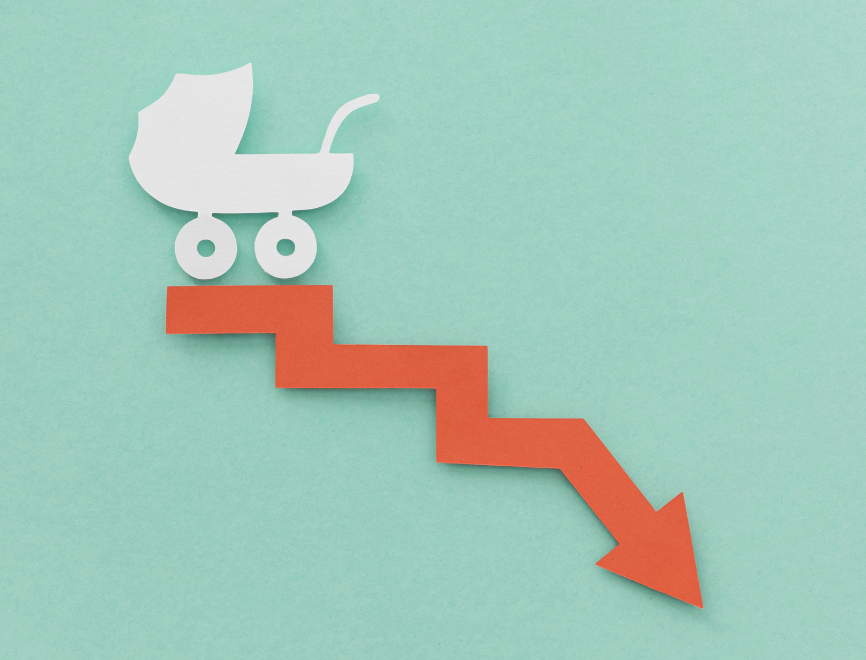Falling fertility rates all around the world means nearly every single country could have much smaller populations by 2100. 23 nations including Spain and Japan are expected to see their populations actually halve by 2100. This also means the population of these countries will dramatically age with as many people tuning 80 as there are being born.
So what’s going on?
World statistics show that fertility rate, which is the average number of children a women gives birth to, is sharply falling. If this rate falls below 2.1 then the size of the population as a whole starts to fall.
Researchers at the University of Washington’s Institute for Health Metrics and Evaluation showed the global fertility rate nearly halved to 2.4 in 2017 compared to 4.7 in 1950. They also projected that this number will fall lower still to 1.7 by 2100.
As a result of this fall in children being born researchers expect the number of people on the planet to peak at 9.7 billion around 2026 before falling to 8.8 billion by the end of the century.
Prof Christopher Murray said ‘that’s a pretty big thing; most of the world is transitioning into natural population decline’ he added ‘I think it’s incredibly hard to think this through and recognise how big a thing this is; it’s extraordinary, we’ll have to reorganise societies’
But why are fertility rates falling?
Contrary to a lot of information on social media this is less like due to to sperm counts. Instead it is being led by woman. With More women choosing to commit to education and work, as well as greater access to contraception, women are choosing to have fewer later in life. In a way falling fertility rates are due to success in other fields.
But why fewer children?
There could be two reasons as to why women are having fewer children. One reason could be that with the easy access to successful contraception methods women are in a position to simply choose to have fewer children as their interest lies in other areas of life.
The second reason is that as women are choosing to have children later in life this reduces the number of reproductive years in which they can fall pregnant and also increases chance of struggling to conceive. Women are born with a specific number of eggs in their ovaries. As a women gets older the number and quality of their eggs decline limiting their ability to conceive. In addition there are increasing number of women and couples opting in for IVF which is another indication of increasing problems with becoming pregnant.
Why is falling fertility rates a problem?
A lot of people may look at this and think well that’s great for the environment and according to prof Murray ‘this would be true except for the inverted age structure (more old people than young) and all the uniformly negative consequences of an inverted age structure. Prof Murray adds ‘this will create enormous social change. It makes me worried because I have an eight year old daughter and I wonder what the world will be like, we need a soft landing’
If you’re still not sure what this means ask yours who will pay taxes in a massively aged world? Who pays for healthcare for the elderly? Who looks after the elderly? Who will be working? What age can people retire from work?
So what can be done about it?
Countries such as the UK have used migration to books their population and compensate for the falling fertility rate and ageing population. But with global fall in fertility rates this can no longer continue to be the answer.
Unlike the world we are living in currently where it is a choice to open our borders or not this will be a world where countries will compete for migrants as there simply won’t be enough of work force available.
Some countries have tried to encourage having children with enhanced maternity and paternity leave, free childcare, financial incentives and extra employment rights but we still don’t know what actually works. Majority of countries like Singapore which has a fertility rate of 1.3 have really struggled making much change.
Prof Murray says ‘I find people laugh it off; they can’t imagine it could be true, they think women will just decide to have more children’
If we don’t find a solution, like many species in the history of the earth, then eventually the species disappears but obviously that’s a few centuries away from us.
Does this mean an undoing of women’s education and access to contraception?
With fertility decline becoming a national problem for all countries responding to the problem is likely yo become an overriding policy concern in many nations. Prof Emil Vollset says “We must not compromise efforts to enhance women’s reproductive health or progress on women’s rights.”
So what do we think at ScreenMe?
Dr Golnoush Golshirazi, CEO and co-founder at ScreenMe, says:
“I believe that the first step we must take is empowering women with education and knowledge about their reproductive health and providing them with the tools to support their fertility. Women’s reproductive health and fertility has always been overlooked. There is a huge gap in research, education and treatment when it comes to reproductive and fertility problems in women”
At School children are thought about contraception and the importance of avoiding a pregnancy but are not any point educated about the fertility rates, the impacts and importance of reproduction and the possibility of struggling to conceive.
Golnoush said:
“by providing women with the tools to gain insight and information on their individual fertility status and health, we are providing them with everything they need to make informed decisions about their fertility journey whether that includes having a child or not”







